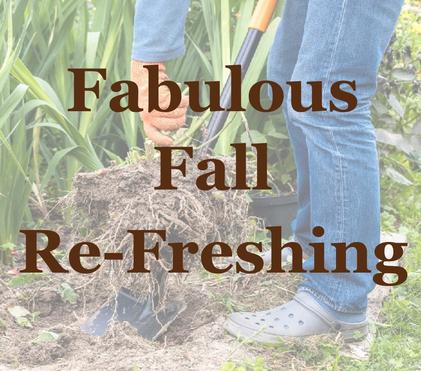Transitioning Your Garden from Summer to Fall
As the long, warm days of summer give way to the cooler, crisp air of fall, it’s time to start thinking about transitioning your garden for the upcoming season. This period is an excellent opportunity to prepare your garden beds, prune, fertilize, and ready your soil for the cooler months ahead. Here are some helpful tips to guide you through the process and ensure your garden thrives this fall.

1. Apply Pre-Emergent on Your Lawn to Prevent Winter Weeds
Winter weeds can quickly take over your lawn if not properly managed. Applying a pre-emergent herbicide now can help prevent these pesky invaders from sprouting. The pre-emergent creates a barrier in the soil that inhibits weed seed germination, keeping your lawn weed-free through fall and into the colder months. Be sure to follow the application instructions on the product you choose, and remember that timing is key—apply before the weeds have a chance to establish themselves.
2. Clean and Trim Roses and Perennials
Your roses and perennials have likely been blooming beautifully all summer, but as the season changes, they’ll need some attention to keep them healthy. Start by cleaning up any dead or damaged leaves and branches, which can harbor pests and diseases over the winter. Next, lightly trim your roses and perennials to encourage a fall perk-up bloom. Once trimmed, feed them lightly with a balanced fertilizer to give them the nutrients they need for a final show of color before the colder weather sets in.
3. Adjust Your Watering Schedule
With the arrival of cooler nights, your plants will require less water. It's essential to gradually adjust your watering schedule to match the changing conditions. For example, if you have been watering for 20 minutes three times a week, consider reducing it to twice a week while still providing a deep watering. As the temperatures continue to drop, you can reduce it further to once a week. Overwatering in cooler weather can lead to root rot and other issues, so be mindful of your garden's needs.
4. Plant Fall Vegetables and Add Seasonal Color
Fall is an excellent time to refresh your vegetable garden with cool-season crops. Remember, fall vegetables are typically those where you eat the plant itself, not the fruit it produces. We call this “Roots and Shoots.” Some great choices include carrots, broccoli, cabbage, onions, lettuce, beets, and chard. These plants thrive in cooler temperatures and will provide you with fresh produce well into the fall months. As far as color goes, Pansies, snapdragons, calendulas, stocks, violas and primrose are the happy colors that ward away the dreary foggy days of winter.
5. Prepare the Soil for the Cooler Months
Before planting your fall vegetables, take the time to prepare your soil. Start by removing any remaining summer crops and debris from your garden beds. Turn the soil to a depth of 6-8 inches to aerate and break up any compacted areas. Incorporate organic matter such as compost or well-rotted manure to replenish nutrients and improve soil structure. This process will help your fall crops establish strong roots and thrive.
By following these tips, you can ensure a smooth transition from summer to fall in your garden. With a little preparation, you’ll be able to enjoy a healthy and vibrant garden throughout the cooler months ahead. And remember, Belmont Nursery has everything you need to get started—from pre-emergent herbicides to the perfect fall veggies and seasonal blooms. Happy gardening!

